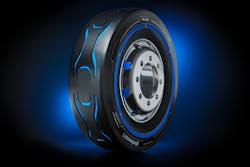As heavy duty truck manufacturers begin to test and produce full battery electric vehicles (BEVs), the technology comes one step closer to being commonplace in fleets around the world. From a maintenance perspective, BEV drivetrains are simpler with fewer moving parts, so on paper, these vehicles should require less maintenance than traditional internal combustion engine (ICE) vehicles. There are, however, factors fleets may not have considered. One such factor is tires and how they will withstand the increased weight and torque demands placed upon them by BEVs.
BEV powertrains vs. tires
BEVs are known for their instantaneous power. Unlike traditional vehicles, there is no diesel engine to build revs and no turbos to spool up to create torque. With a BEV, the torque is present as soon as the driver touches the accelerator.
Additionally, BEVs have heavy battery packs which can weigh more than a full tank of fuel for an ICE, said Marco Rabe, head of research and development for truck tires in the Americas region at Continental.
That type of performance, combined with the additional weight from battery packs, is not conducive to prolonged drive tire wear. The high, instant torque of a BEV can cause excessive rubber loss in the drive tires mainly due to slippage.
“The presence of higher torque levels and the immediacy of the application of torque in EV drivetrains does present challenges for tires,” said Mitch Kritzell, director of commercial tire development, Bridgestone Americas Tire Operations (BATO), U.S. and Canada. “Specifically, the tires are presented with the unique challenge of maintaining the road contact necessary to deliver start-up traction in all conditions while managing the slip and wear that occurs under acceleration.”
The high torque of a BEV can also cause lug cracking in the drive tires due to the increased forces placed upon them, says Al Cohn, director of new market development and engineering support at Pressure Systems International (P.S.I.), a manufacturer of automatic tire inflation systems (ATIS) and tire pressure monitoring systems (TPMS) for commercial trucks and trailers
“With the higher torque, not only can you get fast wear rates, but the tires are more prone to lug-based cracking if you have a lug design for drive tires,” Cohn said. “You can get cracking, heel-toe wear, alternate lug wear – the things commonly associated with higher torque.”
Tires are usually considered one of the top three expenses for a commercial fleet, Rabe said. That means tires could have a major impact on return on investment for fleets considering operating BEVs.
Future tire technologies
As the new type of powertrain becomes more widely tested, tire manufacturers are taking notice and creating tires designed specifically to combat the challenges presented by BEVs. They are working to combine existing technologies such as low rolling resistance, which can help maximize the miles driven on a single charge, with the durability to withstand the stresses of a BEV powertrain.
“In order to keep the wear impact from acceleration torque relatively low, it calls for modifications to both the tread pattern design and the tread compound,” said Continental’s Rabe. “Very low rolling resistance is achieved by a blend of tread compound, tread pattern, and the construction of the tire – and the sidewall in particular – as well as by keeping the overall weight to a minimum. All of these measures need to be carefully coordinated in order to ensure that these tires retain their very safe handling properties.”
Rabe explained that improved rolling resistance works in direct conflict with improved braking distance. It's a case of conflicting goals, he said, because less “grip” both improves the rolling resistance and reduces the braking performance. Tire manufacturers can optimize new product generations with respect to all key properties using innovative technologies, thus lessening the effect of these conflicting goals.
A longer BEV range with lower rolling resistance can only be achieved in compliance with all safety aspects, Rabe added. Braking distance, handling, and directional stability must not be overlooked. The challenge is to find the best compromise between a safe braking distance and low rolling resistance.
Tire manufacturers are also taking load carrying capacities into consideration for BEV tires. Dustin Lancy, commercial product marketing manager at Goodyear, said BEV manufacturers’ tire performance objectives often center on tire rolling resistance and steer axle tire load capacity.
“New technologies for EVs focus on rolling resistance supporting extending the range of the vehicles,” said David Pressley, customer engineering support manager at Michelin North America. “Also, load carrying capacity is important with EVs. Range is important to EV manufacturers and sometimes additional batteries are needed. The size and location of the batteries can increase the load on tires.”
While not all tire manufacturers have current offerings specific to BEVs, many have such products in development, meaning there should be a variety for fleets to choose from by the time BEVs become more readily available.
For now, fleets who are early adopters of the first BEVs would do well to spec tires with low rolling resistance to maximize miles per charge, and proper load capacity ratings to support the extra weight of the batteries.
Rabe suggested that fleets operating BEVs now or expecting to in the future should consider partnering with a tire manufacturer who has already developed expertise with BEV tires.
BEV tire maintenance
Tire maintenance is one aspect that does not change much from ICE vehicles to BEVs. Proper inflation and alignment are of utmost importance in both applications.
“Ensuring proper inflation maintenance and tire alignment are key to ensuring the potential of the tire and vehicle can be realized,” said Bridgestone’s Kritzell. “Without proper inflation and alignment, you can imagine the intended tire contact with the road is not being fully realized, which will impact its ability to deliver on its full traction, wear, and range potential in an EV drivetrain application.”
Continental’s Rabe agreed, adding that proper tire inflation also improves vehicle safety as well as tire casing life for retreading.
“Maintaining proper tire pressure … is the best way to extend tire life and increase retreadability, as well as maintain intended rolling resistance,” Rabe said. “Maintaining proper tire pressure improves tire runout, minimizes irregular wear, reduces fuel consumption, and improves safety. It also delivers 20 percent longer casing life for retreading versus a tire that is just 10 percent underinflated.”
A large part of maintaining proper tire pressure comes down to ensuring drivers are completing pre-trip inspections, Michelin’s Pressley reminded. Tire pressure must be checked properly, too. Thumping a tire to check its air pressure will only identify when a tire is completely flat, Rabe adds. It will not detect the 10 to 20 percent underinflation that can impact tire performance.
Tire monitoring and inflation technologies can streamline this task and help fleets ensure tires are at their proper inflation. TPMS sensors such as Continental’s ContiConnect Yard connect to receivers any time a vehicle enters the yard and alerts maintenance personnel if a tire is detected outside the set air pressure threshold.
This solution and others like it are designed to help fleets maintain proper tire health, allowing them to maximize the efficiency with which each vehicle operates and extending the tread life of each tire as much as possible. These considerations are especially important when it comes to BEVs, since return on investment will rely at least partially on tire longevity and maximizing the number of miles driven per charge.
About the Author
David Brierley
Editor | Fleet Maintenance
David Brierley is the editor of Fleet Maintenance magazine.
Brierley’s education and career have been based in the publishing industry. He is an award-winning writer and comes from a background in automotive, trucking, and heavy equipment. Brierley joined the Endeavor Business Media vehicle repair group in 2017 as managing editor for Fleet Maintenance, PTEN, and Professional Distributor magazines, as well as VehicleServicePros.com. In his current role, he writes for and oversees production of Fleet Maintenance magazine. He has worked in the publishing industry since 2011.


